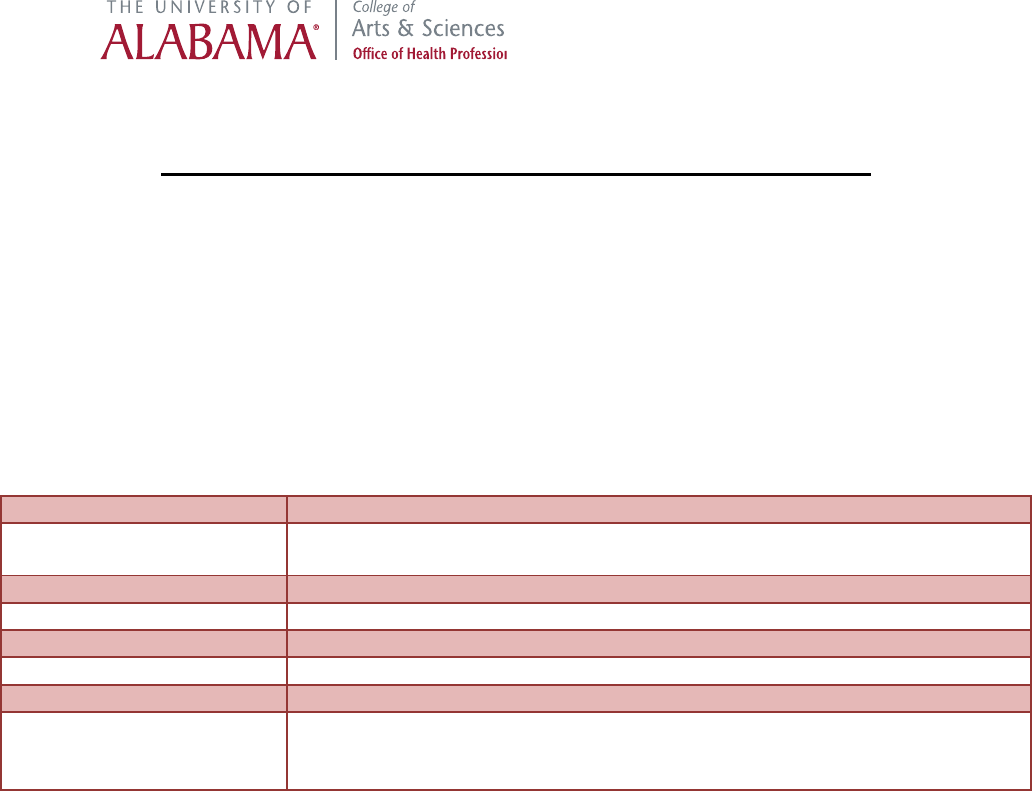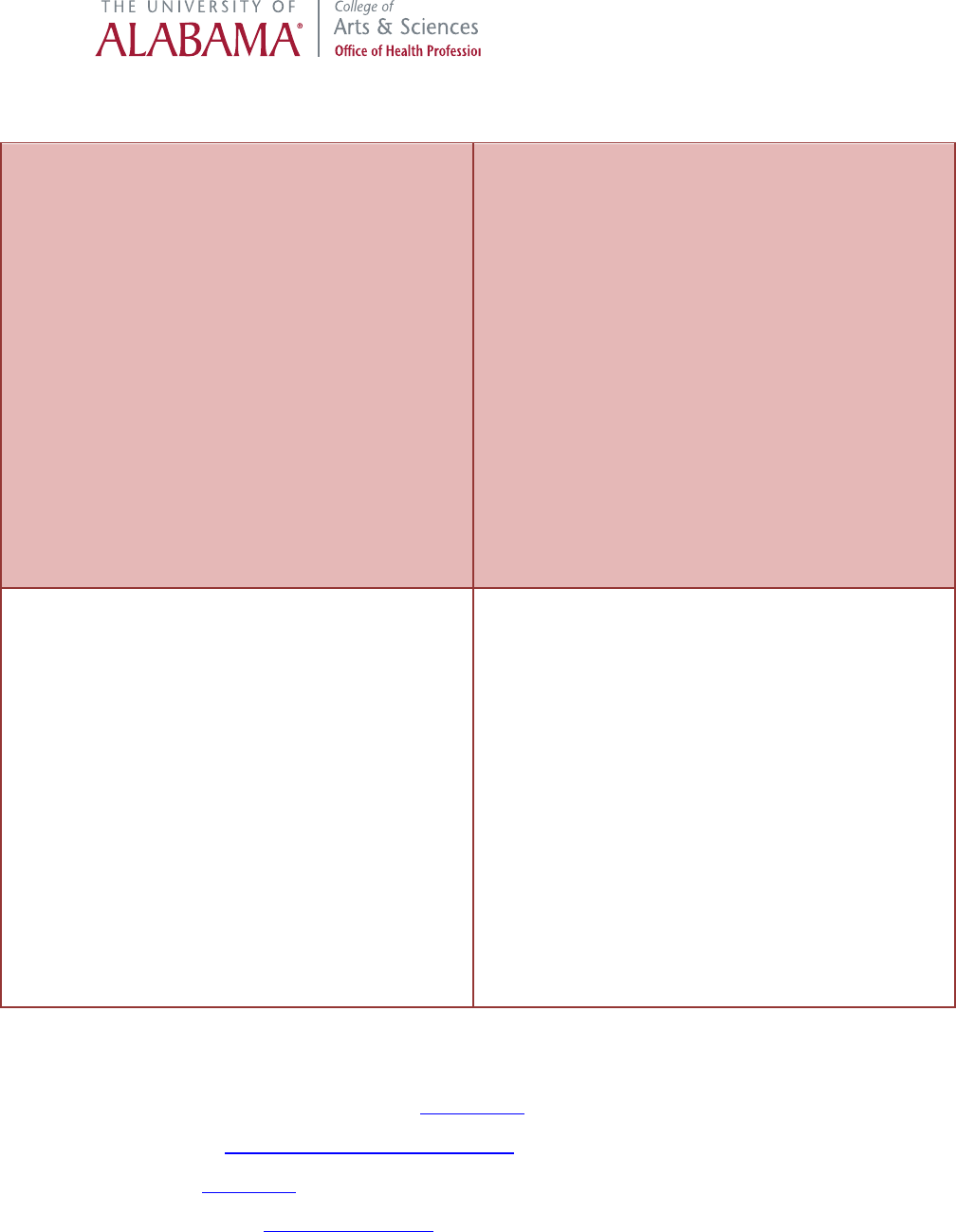
Physical Therapy School Admissions Guide
Physical therapists are experts in movement and function of the body. Physical therapy is the medical
practice that utilizes therapeutic exercise, physical modalities (as massage and electrotherapy),
assistive devices, and patient education and training for the preservation, enhancement, or restoration
of movement and physical function impaired or threatened by disability, injury, or disease. Physical
therapists teach patients the appropriate ways to move or perform particular tasks to prevent further
injury and to promote health and wellness.
PREREQUISITES:
Each physical therapy program establishes its own set of prerequisites. Check the websites of the
schools in that you are most interested in to obtain a current list of undergraduate requirements.
General Biology:
BSC 114/115 and BSC 116/117 or honors equivalent
Anatomy and
Physiology:
BSC 215 and 216 or (BSC 400, 424 and 425 if majoring in biology)
General Chemistry:
CH 101 and CH 102 or honors equivalent
Statistics:
PY 211, BSC 380, or CHS 425 recommended
Physics:
PH 101 and PH 102
Mathematics:
MATH 113
Psychology:
PY 101, 352, 358
HIGHLY
RECOMMENDED:
NHM 101 (Human Nutrition)
HD 203 (Medical Terminology)
ATR 272 (First Aid and Safety)
All prerequisite courses must be completed with a grade of “C” or higher. In addition to
coursework and exam requirements, most PT programs require direct patient observation hour
requirements that will be verified by the Physical Therapist you shadowed.
Some PT programs DO NOT require an undergraduate degree. Please look at program specific
requirements.
EXAM AND GPA:
The Graduate Record Exam (GRE) is a standardized examination that consists of four multiple-choice
sections that cover basic mathematics and reading comprehension skills. The GRE is designed to
measure general academic ability. It is required by most of the American PA schools. Typically,
students take the GRE about one calendar year prior to their intended date of matriculation to
professional school. The GRE is a nationally standardized test, similar to the ACT and SAT. A GRE
score is good for three years at most schools, so taking the test in the spring of junior year does not
necessarily mean that you must enter PA school right after college graduation. Average scores are:
REVISED: 150+ on Verbal and 150+ on Quantitative; 3.5 on Analytical Writing
OLD: 500 on Verbal and 500 on Quantitative (minimum 1000); 3.5 Analytical Writing
Grade Point Average (GPA): Minimum GPA requirements vary from program to program, but MOST
programs have a minimum 3.0 GPA requirement but competitive GPA’s are closer to a 3.5. In addition,
most programs require that all prerequisite courses must be passed with a “C” or better.

TIMELINE:
Freshman Year:
• Connect with a Health Professions
Advisor or Faculty Member
• Start taking basic sciences (See chart
above)
• Think about possible majors (Study what
you love)
• Begin getting involved with volunteer
opportunities (campus and community)
• Start PT experience (PTA, CNA,
Shadowing)
• Look into getting involved in
undergraduate research and talk to
professors
• Go to your professor’s office hours.
• Join some student organizations (Pre-PT
Society)
Sophomore Year:
• Continue with next sequence of courses
• Stay involved in extracurricular activities
(PT, volunteer, etc)
• Begin to think about becoming an officer
in your organizations
• Begin research on professional schools,
their requirements, and assess your
competitiveness
• Investigate GRE preparation options
• BOTTOM LINE: Keep working on the
things you established your first year!!
Junior Year:
• Talk to Health Professions advisor or
faculty member to narrow program
options and assess competitiveness (Fall
semester)
• Register for the GRE (Fall Semester)
• Study for GRE and take it
(Spring/Summer)
• Identify 3-5 individuals to write letters of
recommendation (Spring Semester)
• Complete Application (PTCAS) (Spring
Semester-Summer)
• Schedule a mock interview with Career
Services
• Keep working on the things you have
established thus far
Senior Year:
• Submit Application(s) if you haven’t
already (Fall semester)
• Wait to be contacted for interview from
medical schools
• Continue with activities and professional
experiences/shadowing
• Talk with an advisor about Plan B if
necessary
• Finish degree requirements and
GRADUATE!
RESOURCES:
The American Physical Therapy Association (APTA): www.apta.org
APTA Program Perquisites: http://www.ptcas.org/ProgramPrereqs/
GRE Information/Dates: www.ets.org
UA Health Professions Website: www.prehealth.ua.edu
Baffi-Dugan, C., Cannon, R. E., Bingham, R., & Corder, B. W. (2011). Health professions admissions guide: Strategy for
success. Champaign, IL: National Association of Advisors for the Health Professions.
